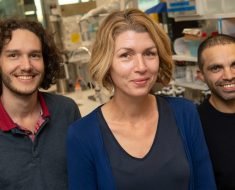Sexually, we’ve come a long way. Women have never been more empowered, or more informed. But it turns out that our new-found sexual fabulousness goes hand in hand with less fabulous news – STIs are on the rise. Chlamydia is still the most common, “but in the last few years gonorrhoea diagnoses in 25- to 39-year old women have increased by about 90 per cent,” says Professor Rebecca Guy from the Kirby Institute, which compiles an annual STI report in Oz. More fun trivia? Syphilis cases are also rising. Yikes!
“Overseas travel is a suspected contributor – people have sex in countries where STIs are rife, condoms break or slip off if someone is a bit drunk, and then they bring infections back with them,” says Professor Christopher Fairley, director of Melbourne Sexual Health Centre.
And it’s not just infections we need to think about – almost one in five of us have experienced an unplanned pregnancy, reveals a survey by Galaxy Research and MSD Australia (although it’s estimated that figure may be closer to 50 per cent).
If all of this has put the willies up you (pun intended), there’s good news: sex ed 2018-style offers new ideas, new inventions and less cringe factor. Here’s the lowdown…
NO GLOVE, NO LOVE
It’s not news that condoms are the best way to protect yourself against STIs. But if you’re one of the 68 per cent of women not comfortable buying them, you’ll welcome the launch of Moments Condoms. The company offers online ordering and discreet packaging that doesn’t scream, ‘I’m out to get lucky’ if they fall out of your bag.
Meanwhile, if he struggles to get on board with rubbers, “pick polyurethane over latex,” says Fairley. “It offers maximum sensation.” Sagami is one polyurethane range, or look for another super-thin material called polyisoprene, used in brands such as Ansell Skyn.
And watch this space for hydrogel condoms. Pros at the University of Wollongong are working with hydrogel, a water-heavy material that’s soft, squishy and wet (just like we are). It also stretches extremely thin. The upshot? These condoms will deliver serious ensation when they arrive in a few years.
I SPY AN STI
Decoding symptoms just got easier with the launch of the world’s first ever STI diagnostic algorithm at ispysti.org. Enter your symptoms into the tool, created by Melbourne Sexual Health Centre, and it’ll predict whether an STI is to blame. “You’ll see close-ups of lumps and bumps, but it can help recognise what your symptoms might be,” says Fairley. If it suggests there might be an issue, visit your GP or a sexual health clinic for confirmation.
BACK TO NATURAL
The hottest development in our contraception approach? A rise in natural methods such as withdrawal and fertility tracking, which uses signals (eg, changing body temp) that aim to predict “safe periods”.
According to a Monash University study, 15 per cent of Aussies are now fans – a jump from less than 7 per cent in past research.
Why the trend? Experts reckon it could be an offshoot of the #cleaneating craze, where we’re moving away from having artificial substances in our body. But know this: withdrawal is never safe as sperm is released before orgasm. In fact, according to Family Planning NSW stats, natural approaches like this can have a success rate as low as 75 per cent. Not great odds.
As for fertility tracking, it’s had a makeover with apps such as Natural Cycles claiming to do the hard data crunching for you. “But technology doesn’t make it bulletproof,” warns Dr Deborah Bateson, medical director of Family Planning NSW.
“You have to be very dedicated in consistently providing the correct data to get the algorithms to work correctly. You have to abstain or use other methods for large parts of the cycle, so couples have to be very motivated. It’s also most successful in people who have very regular cycles. We suggest anyone trying it has coaching.” Lesson learnt.
Source: Read Full Article





